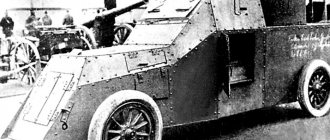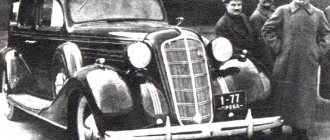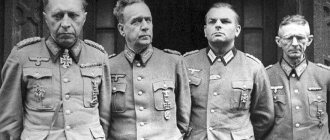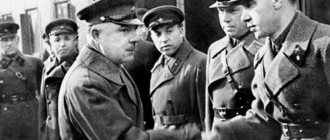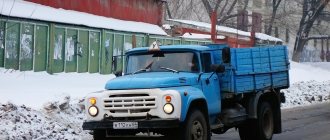Home » Cars » Peaceful and military destinies of the GAZ-AAA car
Cars
boroda 04/07/2019 1957
15
in Favoritesin Favoritesfrom Favorites 9
In the pre-war period, the most important task of the Soviet automobile industry was the development of serial production of domestic three-axle trucks with two rear drive axles, which were then classified as off-road vehicles. Work in this direction was carried out in emergency mode under the slogan “Give the Red Army a three-axle!”
Testing of an experimental GAZ-31 truck with side free-rotating spare wheels
This article is devoted to one of these vehicles - the two-ton GAZ-AAA truck, unified with the two-axle GAZ-AA semi-truck and designed for primary use in the armed forces of the USSR.
Out of habit, an order for three-axle trucks was sent to the American company Ford, but there was no such vehicle in its program, and the prototypes hastily assembled overseas did not meet our requirements. As a result, the modification of the insignificantly updated vehicle had to be done by Soviet engineers, whose work was supervised by representatives of the People's Commissariat of Defense, the OGPU and the NKVD.
The first Soviet serial three-axle truck GAZ-AAA of early production
GAZ-AAA in the Soviet-Finnish War (from the collections of the War Museum in Helsinki)
The first samples of the 40-horsepower GAZ-AAA truck with main worm gears appeared at the end of 1934, and then it took another year to organize their production. In 1938, the modernized version received a GAZ-M engine with 50 horsepower. At the same time, an experimental reinforced model of the GAZ-31 with a 76-horsepower engine was built for the future replacement of the GAZ-AAA.
Experienced high-power GAZ-31 truck with removable tracks
In the first two years of the war, GAZ-AAA was produced in simplified versions, corresponding to the related model GAZ-MM, but in the summer of 1943, after heavy bombing of the Gorky Automobile Plant, their production had to be stopped in favor of assembling Lend-Lease vehicles. In total, over 37 thousand GAZ-AAA trucks were assembled, including about 10 thousand during the war.
Military-style GAZ-AAA trucks with one headlight and a cabin lined with clapboard
Military versions of GAZ-AAA trucks
Initially, the vehicle fully met the requirements of the military in terms of maneuverability, reliability, ease of maintenance, the ability to transport up to 20 personnel, tow field guns and carry heavier equipment and weapons.
At the parade there are flatbed trucks with cross benches for 16 soldiers
Transportation in the back of a GAZ-AAA of a regimental 120-mm mortar with a combat crew
GAZ-AAA vehicles with 76-mm cannons at a military parade in Moscow on November 7, 1941
Meanwhile, the range of special army versions on the GAZ-AAA chassis was significantly inferior to the lorry, but the range of armored vehicles created on it had no equal either in the past or in the future.
American brother of the Soviet “three-axle”
As sad as it is to admit, the prototype of Soviet trucks mounted on three axles is the American Ford-Timken car. It is worth noting that in the USA, vehicles of this class, characterized by increased cross-country ability, were not popular, but in the USSR, where off-road problems never lost their relevance, such trucks were very useful. Therefore, since 1931, located in Nizhny Novgorod (later renamed the city of Gorky), it begins to manufacture domestic copies of Timkens from components supplied from America.
It is clear that this could not continue for long - the Land of Soviets needed its own car entirely.
Radio equipment
In peacetime, the GAZ-AAA was equipped with a mobile transceiver radio unit RUK and tube radio stations 11AK, which at the first stage of the war were replaced by the duplex radio station RSB-F with a two-way communication range of up to 1.5 thousand kilometers.
Powerful military radio station RSB-F in a wooden body
Radar station "Redut-40" in a rotating van
In the early 1940s, a highly secret two-antenna radar station RUS-2 “Redut-40” appeared for long-range detection (up to 100 km), which revolutionized air defense technology. It used a GAZ-AAA vehicle with four jacks and a full-turn receiving equipment room, which rotated around a vertical axis using an electric drive, receiving information from a synchronously rotating transmitting cabin based on the ZIS-6.
First steps"
The creation of a new army tractor, the GAZ-34, capable of transporting cargo weighing up to three tons, began in 1964. On July 1 of the same year, the car plant began serial production of the GAZ-66, a two-axle cabover truck. The GAZ-34 car was very similar in appearance to its two-axle brother. The difference was in the overall length and the presence of a third axis.
At the same time, in 1964, the first prototype model appeared, followed by two more cars, but these were experimental workers. They had the cab from the 66 installed, which could also be folded down to gain access to the engine. And to the vertical slits of the air intake, additional horizontal, shorter ones were added. There were no such slots on the production cabs of the 66th.
Having passed factory tests, both cars were launched into a motor rally, first for 25, and then for 50 thousand km.
Three more GAZ-34 cars with certain modifications left the assembly line in 1967. And by the end of December 1968, both internal and military tests had passed.
The designers unified a number of components and assemblies, as well as the cabin and body of the 34, with the production model GAZ-66A, equipped with a winch. The Z4 was also equipped with a system that regulates tire pressure, which was later installed, along with a winch, on the GAZ-66-02, which was mass-produced by the plant since 1968.
It was difficult to call the characteristics of the GAZ-34 unique, since it was a symbiosis of different trucks, and not only those produced at the Gorky plant.
Auto repair shops
Taking into account the same dimensions of the chassis mounting area as the semi-truck, the PM-3 camp workshops were installed on the GAZ-AAA, as well as the heavier standard PM-5-6 - a type B flywheel designed for installation on the ZIS-5. It was equipped with increased sets of tools and materials, and some versions were placed in special, more spacious and heavier bodies with crews of up to seven people. During the war, this base produced a TRM for repairing armored vehicles in the field.
Tank repair workshop in the back of a type B fly truck with a rear crane (from the archive of N. Markov)
Fuel service vehicles
The payload of the GAZ-AAA increased by half a ton allowed it to be used as a base for military refueling vehicles with its own pumping equipment. In 1938, the USSR Air Force began production of the lightweight BZ-38 with a streamlined tank lining with a capacity of 1.5 thousand liters and working compartments.
The first airfield tanker BZ-38 with a rear control cabin
MZ-38 oil tanker with a heating system was used to transport and refuel aircraft with hot oil . Until the end of the war, a simplified BZ-38U with filling hoses placed directly on the tank served in the Red Army.
Aerodrome and engineering equipment
Aerodrome equipment on the GAZ-AAA included the later 50-horsepower version of the AS-2 , which provided increased torque required when starting heavier propeller-driven aircraft. In terms of configuration, it was practically no different from the AC-1 model based on a semi-truck.
Aerodrome starter AS-2 during mechanized starting of an aircraft engine
During the war years, the new AES-3 with a 15-kilowatt DC generator was installed on simplified three-axle machines, which provided electricity to 15 lighting spotlights and 16 points for connecting electrical appliances and field workshop tools.
AES-3 power plant in a flatbed body on a military-style GAZ-AAA chassis
Cabin, controls and driver's workplace
A two-seater metal cabin was installed on the chassis in front of the vehicle. To facilitate access to the engine compartment, opening sides were made on each side of the cab hood. The cabin roof was made with a wooden insert covered with canvas, since at that time Soviet industry could not produce solid metal sheets of this size.
The doors were hung on front hinges. The solid windshield could be rotated in the frame and fixed with wings. To protect from the sun, a visor was provided above the windshield. There was only one windshield wiper - in front of the driver's face, on the upper frame of the windshield. It had a vacuum drive, the hose of which was connected to the carburetor inlet manifold.
A rear view mirror was mounted on the left pillar of the cab. To protect the body from damage, a front bumper made of two elastic steel strips was provided. At night, the road was illuminated by two electric headlights. They were installed on the cross member between the front fenders, and a sound signal was attached to it. Some trucks were produced with only one headlight, located on the driver's side.
For easy entry into the cabin there were steps that were connected to the front fenders. In the cockpit, on the dashboard there was a panel with an ignition switch (on the left) and three instruments: at the top in the center - an optical fuel level indicator, on the right - an ammeter and at the bottom - a speedometer, in which the numbers printed on the drum replaced each other in the stationary instrument window.
To illuminate the instruments, there was a common external light bulb mounted in the upper part of the panel. The steering gear ratio with a globoidal worm and double roller is 16.6. The steering wheel was four-spoke, with a horn button and a light switch located in its center. Behind the steering wheel hub there were two levers: the left one, intended for manually adjusting the ignition timing, and the right one, for fixing the position of the carburetor throttle valve. The starter had to be activated by a trigger, which was located above the gas pedal, and just below and to the right of this gas pedal there was a support for the driver’s right leg.
Chemical service machines
In the mid-1930s, a lightweight auto-degassing machine ADM-750 , consisting of a tank-barrel, two tin washing baths, a hand pump and hoses with sprayers and fire nozzles. Since 1940, a sanitary-epidemiological laboratory has been produced to study and analyze the degree of contamination of the area.
Degassing machine ADM-750 in the back of a GAZ-AAA (from the archive of N. Markov)
Testing of the chemical machine BKhM-1 for contamination of the area (film frame)
In the pre-war years, in an atmosphere of special secrecy, the development of special vehicles was carried out to contaminate the area with toxic substances to prevent the enemy’s offensive actions. This role was assigned to chemical combat vehicles (CCVs), which were tank trucks with pumping equipment, containers for toxic compounds and systems for mixing and spraying them.
One of the first were test samples of the BKhM-1 on a GAZ-AAA chassis with a regular or armored cab and cylindrical tanks for 800 liters of toxic liquids. They were tested, but it never came to the point of using them in combat.
Specifications
The GAZ 51 two-axle rear-wheel drive truck was capable of reaching a maximum speed of 70 km/h.
Engine
At the end of the 1930s, the Gorky Automobile Plant launched production of the in-line GAZ-11 engine, which was initially a licensed version of the engine from the American company Dodge. The engine was very technologically advanced, and no non-ferrous metals were used for the manufacture of its parts, with the exception of the pistons. Significantly improved during the war years, this power unit was used for a long time on various vehicles, including buses, special vehicles and tractors, and was produced in the USSR until 1989.
The engine had 6 cylinders, its displacement was 3485 cc. The engine power of 70 horsepower was not the maximum and was restrained by the crankshaft speed limiter, the maximum operating value of which was allowed at 2800 rpm. This added endurance and reliability to the engine, which did not tolerate prolonged increased loads well, which was complicated by the large gear ratio of the main rear axle pair.
Suspension and transmission
The GAZ-51 suspension was considered quite progressive even by modern standards. It consisted of 4 longitudinal semi-elliptic springs and 2 springs related to the rear axle. The suspension also used lever-type hydraulic shock absorbers, which were replaced by telescopic elements in the late 1960s. The suspension of the currently produced Lawn Next truck has a similar design. The permissible load on the front axle was 1610 kg, on the rear axle - 3760 kg.
The GAZ-51 transmission consisted of a manual 4-speed gearbox without synchronizers, a single-plate dry clutch and a single-stage final drive.
Rear axle and chassis
In the truck chassis, a rigid front axle ensured maximum stability. The rear axle had a single final drive and was assembled inside a beam, complete with a split housing. This design was considered very perfect, and was later almost completely repeated on the three-axle ZiS-151 truck. The rear axle of the GAZ-51 was driving.
Machine gun and cannon weapons
In peacetime, an extensive set of light weapons from single to quadruple machine guns, as well as cannons of 25 and 37 mm caliber was installed in the side bodies of GAZ-AAA trucks, as well as GAZ-AA, without any special modifications. Next to them were boxes of ammunition and places for combat crews. By the beginning of the war, the Red Army had over two thousand of these vehicles in service, but in real battles they turned out to be ineffective.
A regular GAZ-AAA truck with a coaxial machine gun at a parade in Mongolia
Cars with quadruple 4M Tokarev machine guns at a parade in Kyiv
25 mm anti-aircraft gun in a GAZ-AAA body with folded sides
Self-propelled artillery unit SU-12 at the parade on Red Square (film shot)
The SU-12 self-propelled artillery mount with a 76.2 mm regimental gun and frontal armor shield was mounted on a semi-armored three-axle chassis. The poor maneuverability and vulnerability of these systems forced them to abandon their combat use.
Staff and ambulances
GAZ-05-193 bus based on the GAZ-AAA, equipped with a glazed wood-metal body with eight workplaces, was the most common headquarters vehicle for the highest command level of the Red Army. Its equipment included a central folding table with two longitudinal sofas, cabinets and shelves for documentation and maps, wired and radio communications, sockets for connecting to external power sources, a hot air heater and curtains on the windows.
Staff bus GAZ-05-193 of the top leadership of the Red Army on a wartime chassis
The special ambulance bus GAZ-05-194 , unified with the headquarters one, was distinguished by side windows with frosted glass, images of the red cross, longitudinal benches in the cabin and the installation of two-tier stretchers for transporting up to four bedridden wounded or 15 seated ones. One of these machines served as a mobile X-ray room.
Pre-war version of the GAZ-05-194 medical service bus (film frame)
Front-line sound broadcasting and topographic stations, light loading cranes, mobile printing houses and film mobiles were also installed on GAZ-AAA trucks.
Mobile printing house in the flatbed of a pre-war GAZ-AAA car



